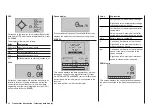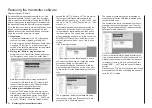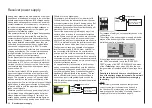
54
Receiver initialization
Receiver initialization
Preliminary remarks
Receiver system
The
mc-16
HoTT radio control set includes a GR-
16 bi-directional 2.4 GHz receiver, with sockets for
a maximum of eight servos. The
mc-20
HoTT set
includes a GR-24 bi-directional 2.4 GHz receiver with
sockets for a maximum of twelve servos.
If you switch on the GR-16 HoTT receiver supplied in
the
mc-16
HoTT set, or the GR-24 HoTT receiver
supplied in the
mc-20
HoTT set, and “its” transmit-
ter is not in range, or is switched off, then the receiv-
er’s red LED will illuminate continuously for about 1 s
then begin to blink slowly. This indicates the receiver
has not (yet) established a link to a Graupner|SJ
HoTT transmitter. If a link has been established, the
green LED will illuminate continuously and the red
LED will extinguish.
In order to establish a link to the transmitter, the
Graupner|SJ HoTT receiver must first be “bound” to
“its” particular model memory in “its” Graupner|SJ
HoTT transmitter. This procedure is known as “bind-
ing”. This “binding” linkage is only necessary once
for each receiver/model memory combination. Refer
to pages 87 or 95. The “binding” procedure has
been done at the factory for model memory 1 of the
units delivered together as a set so this “binding” pro-
cedure will only be necessary to link additional receiv-
ers or if a memory location change becomes neces-
sary (and – e. g. after a change of transmitter – can be
repeated anytime).
On-board voltage display
The current voltage of the receiver’s power supply will
be shown in the right side of the transmitter’s screen
if a telemetry link exists between the receiver and
transmitter:
#01
2:22h
Stp
Flt
0:00
0:00
5.5V
3.9V
M
HoTT
Temperature warning
Should the receiver’s temperature sink below an
adjustable threshold (default value -10 °C) or rise
above an adjustable threshold (default value +55 °C),
an acoustic warning will be issued by the transmitter
in the form of a uniform beep of about 1 s duration.
The aforementioned threshold limits are stored and
adjusted in the receiver.
Servo connections and polarity
Graupner/SJ HoTT receiver servo connections are
numbered. The connectors used are keyed against
polarity reversal. Pay attention to the small side
chamfers when plugging in these connectors. Never
use force.
The supply voltage is bussed across (i. e. common
for) all numbered connections.
The two vertical sockets at the extreme edge of the
GR-16 and GR-24 receivers are intended for the bat-
tery connection. On the GR-16 these two sockets are
marked “1+B-” and “6+B-”. On the GR-24 these two
sockets are marked “11+B-” and “12+B-”. However,
you can also connect the corresponding servos to
these two sockets in parallel with the power supply
simply by using a Y-lead, Order No. 3936.11.
Do not reverse the polarity of this connection.
Reversed polarity could destroy the receiver and
devices attached to it.
The function of every individual channel is determined
by the transmitter used, not by the receiver. It is not
only the throttle servo connection which is different for
every manufacturer and model type. For example, in
Graupner remote control systems the throttle servo is
on channel 1 for winged aircraft and on channel 6 for
helicopter models.
Follow the installation instructions on page 64 for
the receiver, the receiver antenna and for mounting
the servo.
Concluding notices:
• The significantly greater servo resolution charac-
teristic of the HoTT system produces a noticeably
firmer response behaviour in comparison to previ-
ous technology. Please take the time to familiarize
yourself with this sensitive behaviour.
• If you have a speed controller with integrated
BEC* arranged in parallel with the receiver battery,
its positive pole (red cable) may to be removed
from the 3-pole connector. Be sure to look for no-
tices about this in the instructions for the speed
controller used.
With a small screwdriver,
carefully lift up the connec-
tor’s center latch (1) just a bit
then pull out the red lead (2)
and tape it up with insulation
tape to prevent possible short
circuits (3).
Reset
To execute a reset of the receiver, press and hold the
SET button on the receiver’s top-side while switching
the power supply on. Hold the receiver’s SET but-
ton pressed in for about three seconds until the LED,
flashing slowly red / green, goes out for about two
seconds.
If you have carried out the reset with the transmitter
switched off, or with an unbound receiver, the green
and red LEDs fitted to the GR-16 and GR-24 receiv-
ers (supplied as standard in the sets) flash four times
for around three seconds, after which both LEDs go
* Battery Elimination Circuit
red
1
2
3
Summary of Contents for HoTT MC-16 Series
Page 1: ...Programming Manual mc 16 mc 20 HoTT 1 en mc 16 mc 20...
Page 27: ...27 For your notes...
Page 53: ...53 For your notes...
Page 61: ...61 For your notes...
Page 65: ...65 For your notes...
Page 71: ...71 For your notes...
Page 103: ...103 For your notes...
Page 107: ...107 For your notes...
Page 111: ...111 For your notes...
Page 155: ...155 For your notes...
Page 165: ...165 For your notes...
Page 201: ...201 For your notes...
Page 229: ...229 For your notes...
Page 231: ...231 For your notes...
Page 261: ...261 For your notes...
Page 265: ...265 For your notes...
Page 301: ...301 For your notes...
Page 327: ...327 For your notes...
Page 328: ...328 For your notes...
















































